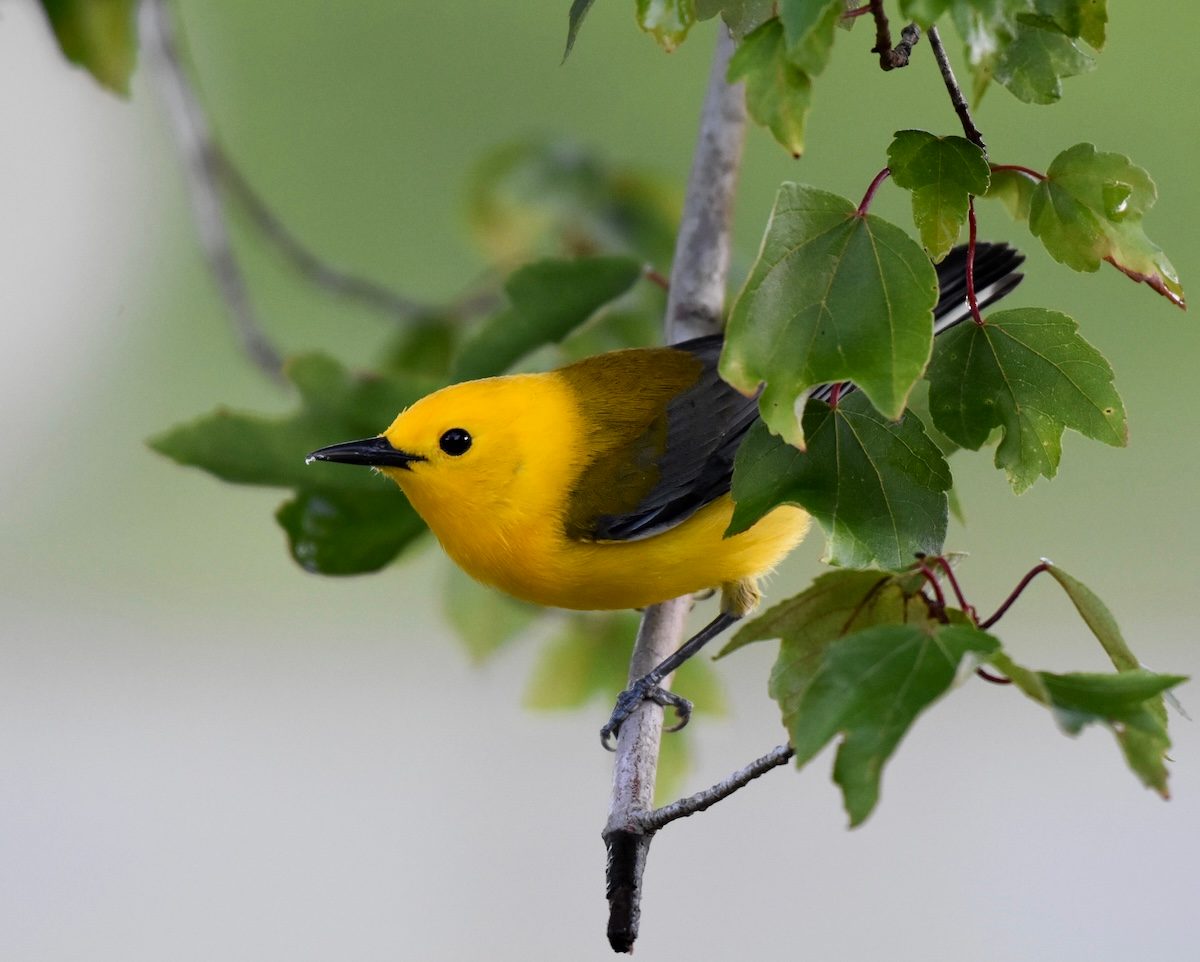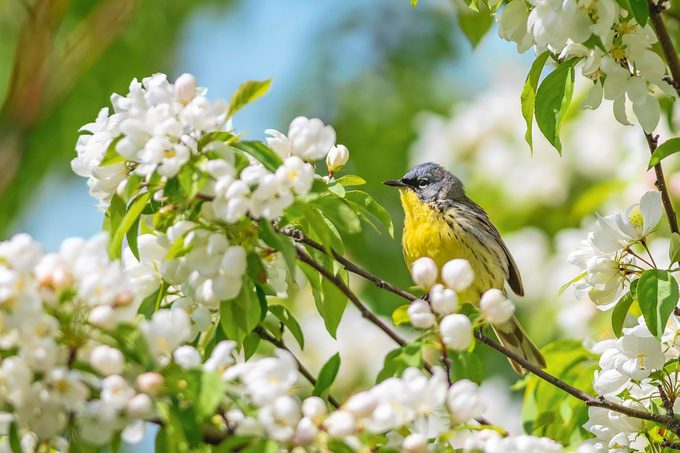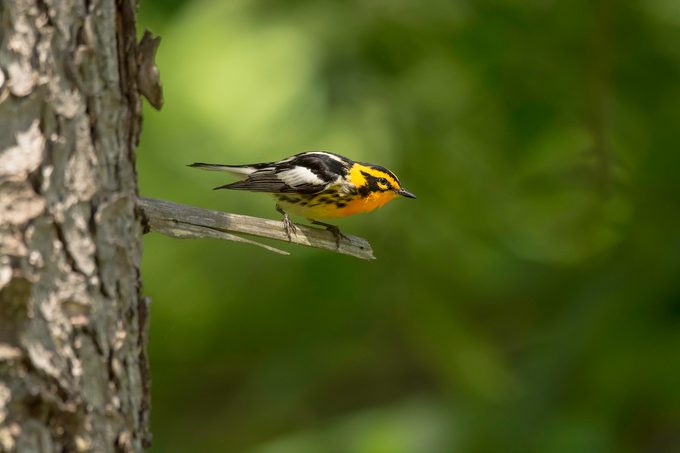Even casual birders get excited during warbler migration season! Try these tips to identify the most warblers this spring.

Warbler Migration Tips for Every Type of Birder

On This Page
Prepare for Warbler Migration Season

There are many different kinds of birders. Some travel the world to find rare, exotic species. Some prefer to stay home, watching the visitors to their backyard feeders. Others are up at dawn, hiking the trails at the park with binoculars in tow. Migration season brings all these birders together, allowing even beginning birders the chance to see unusual species close to home. Warbler migration is especially fun in the spring, since these little birds are all wearing their best breeding colors.
This time of year, a little extra effort can yield wonderful results. Here are a few tips to make the most of warbler migration season.
Follow BirdCast and Monitor eBird
A little planning can help you find many more birds. BirdCast offers birding forecasts by region, letting you know when to expect waves of birds and which types are currently arriving and peaking during migration. The eBird website and app allows you to search by hotspot, so you can take a look at other birders’ recent lists and see what you might expect to find.
Discover more bird migration secrets.
Take Lots of Photos, Even Bad Ones

I consider a camera to be just as essential to birding as a good pair of binoculars. On a usual day of birding, I’ll take hundreds if not thousands of photos. Most of these are absolutely terrible and will be deleted that same day. But I find photography very valuable for helping to identify the birds I’ve seen. I’m still learning my warbler species, so I don’t always recognize them immediately.
Even a blurry or far-off photo can help me ID birds when I get back home. You can also upload your birding photos into the Merlin app for a helping hand.
Learn About Warblers and Their Songs in Advance

Of course, the best way to enjoy birding is to learn to recognize more species by sight. Knowing their songs is even better, since it allows you to know what bird you’re looking for.
There are many tools and books out there for getting to know warblers. I also recommend having a good field guide that you can consult along the way. Birding flashcards are another fun way to boost your birding knowledge.
Learn how to identify a yellow warbler.
Don’t Forget the Extended Warbler Family

Keep in mind that you also should look for birds in the warbler family that aren’t actually named warblers, such as the American redstart, ovenbird, Northern waterthrush, common yellowthroat and Northern parula.
Attend Birding Festivals or Field Trips

Birding festivals abound during warbler migration. One of the best is the Biggest Week in American Birding in Ohio, where you may find Birds & Blooms editors in attendance. Your local Audubon society is likely to offer field trips during migration, too, so be sure to ask what they have going on.
Be sure to either call ahead or visit the festival’s website for the latest information.
Talk to Other Birders

While you’re out and about, don’t be afraid to talk with other birders. (You’ll recognize them by their binoculars and peculiar habit of walking along looking up into the trees rather than at the ground.) Nearly all birders are happy to share their spottings, and point you in the direction of a good find.
Learn more about the foods warblers eat and how to attract them.
The Top Warbler Hotspots to Visit in Spring

You can find warblers in your area no matter where you live, but there are a few warbler hotspots around the country that are exceptional places to spot these beautiful birds.
- High Island, Texas: High Island is one of the most famous warbler hotspots in the whole country. The birding is always good during spring migration (best in April), but if you happen to visit High Island on the right day, you might experience a fall out of warblers. Fall outs are incredible events where the birds get slowed down during their migration over the Gulf of Mexico and use up their stored energy very quickly. When they reach land, they must find the first good habitat with shelter and food. Quality habitat like that found at High Island is critical for the survival of hundreds of thousands of migrating birds.
- Magee Marsh, Toledo, Ohio: The park is located right on the shores of Lake Erie. Although small, the area attracts an incredible number of migrating warblers during May. It is not uncommon to find over 30 warbler species in the area in just a few days’ time. Be sure to stop at Black Swamp Bird Observatory at the entrance to Magee Marsh to learn about their important research. There are also many other wildlife areas in northwest Ohio that are worth visiting while in the area such as Oak Openings, Metzger Marsh, and Pipe Creek Wildlife Area.
- Cape May, New Jersey: Cape May has a long tradition as one of the best warbler hotspots on the East Coast. There are many different places that you can go birding throughout the Cape May area, and this leads to some fantastic species totals. Maybe you’ll even spot a Cape May warbler.
- Dry Tortugas National Park, Florida Keys: The Dry Tortugas is a very interesting warbler hotspot. The site is only accessible via boat or seaplane making it a rather difficult place to get to, but that is part of the fun. Once you are there, the birding can be fantastic! You will be looking for warblers on the grounds of an old U.S. fort. Inside the fort, a water feature provides the only fresh water available on the islands making it a magnet for migrating birds. Find a spot to sit and then enjoy the show as the warblers come in to get a drink!
- Fort Morgan, Alabama: This is the least known of the warbler hotspots that I’ve included, but that doesn’t mean it’s not worth visiting! The Fort Morgan State Historic Site sits at the tip of the Fort Morgan Peninsula that sticks out into the Gulf of Mexico. The location makes it an ideal place for warblers on their northward migration to stop and fuel up before continuing on.
Additional reporting by Rob Ripma




















